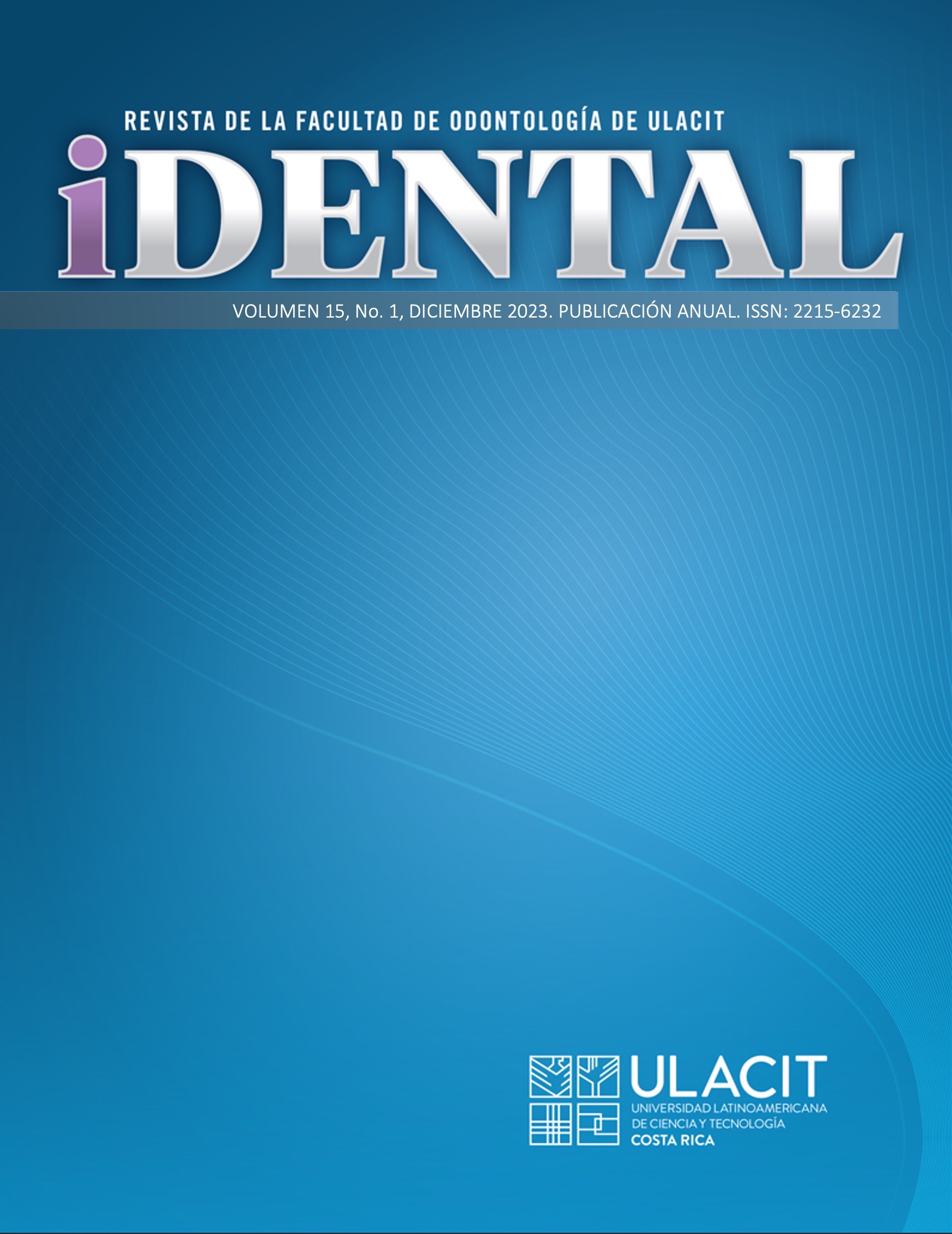Published 2023-12-23
Keywords
- TikTok™,
- cáncer oral,
- cáncer de boca,
- Videos
How to Cite
Copyright (c) 2023 iDental

This work is licensed under a Creative Commons Attribution-NonCommercial-ShareAlike 4.0 International License.
Downloads
Abstract
A video search was conducted on the social network TikTok using the hashtags "#canceroral", "#canceroral", "#cancerofmouth", "#cancerofmouth", "#cancerbuccal" and "#cancerbuccal". The search was conducted by re-downloading the app on an iPhone 6 with a cleared cache. The first 25 "most relevant" videos on each page were collected, because statistics indicate that most users do not watch those after the third page. Four categories were analyzed: video information, video creator information, format analysis, and content quality. In this article, it was shown that TikTok videos on oral cancer and their success in viralization on the platform will depend on their visual appeal to users, not so much on the quality of the information contained. The predominant type of video was that of a person talking, obtaining a greater number of comments and likes. However, the videos that only presented images were the ones that got the most shares from the population. In Spanish there is no study like the one presented above, which makes it unique in its field and allows for a large collection of information. The information on oral cancer in Spanish on TikTok is very limited. It was determined that most of the information is little or moderately useful, mainly talking about prevention and the manifestations of the pathology, but there is a lot of misinformation regarding the causes, such as prolonged exposure to the sun.
References
- Abati, S., Bramati, C., Bondi, S., Lissoni, A., & Trimarchi, M. (2020, December 2). Oral cancer and precancer: A narrative review on the relevance of early diagnosis. International Journal of Environmental Research and Public Health, Vol. 17, pp. 1–14. https://doi.org/10.3390/ijerph17249160
- Becerra-Chauca, N., & Taype-Rondan, A. (2020). TikTok: ¿una nueva herramienta educativa para combatir la COVID-19? ACTA MÉDICA PERUANA, 37(2), 249–251. https://doi.org/10.35663/amp.2020.372.998
- Basch, C. H., Fera, J., Pierce, I., & Basch, C. E. (2021). Promoting mask use on Tik Tok: Descriptive, cross-sectional study. JMIR Public Health and Surveillance, 7(2), e26392. https://doi.org/10.2196/26392
- Chiu, S. F., Ho, C. H., Chen, Y. C., Wu, L. W., Chen, Y. L., Wu, J. H., … Chiang, W. F. (2021). Malignant transformation of oral potentially malignant disorders in Taiwan An observational nationwide population database study. Medicine (United States), 100(9). https://doi.org/10.1097/MD.0000000000024934
- Dewshi, C. (2021, October 1). Dentistry on TikTok - oh no. British Dental Journal, Vol. 231, p. 379. https://doi.org/10.1038/s41415-021-3546-2
- Delouya, S. (2022). Nearly Half of Gen Z Prefers TikTok and Instagram Over Google Search. Nearly Half of Gen Z Is Using TikTok and Instagram for Search Instead of Google, According to Google’s Own Data. Business Insider. https://www.businessinsider.com/nearly-half-genz-use-tiktok-instagram-over-google-search-2022-7
- Dhanuthai, K., Rojanawatsirivej, S., Thosaporn, W., Kintarak, S., Subarnbhesaj, A., Darling, M., … Shakib, P. A. (2018). Oral cancer: A multicenter study. Medicina Oral Patología Oral y Cirugia Bucal, 23(1), e23–e29. https://doi.org/10.4317/medoral.21999
- García-Marín, D. (2022). Viralizing the truth: Predictive factors of fact-checkers’ engagement on TikTok. Profesional de La Información, 31(2). https://doi.org/10.3145/epi.2022.mar.10
- Hassona, Y., Taimeh, D., Marahleh, A., & Scully, C. (2016). YouTube as a source of information on mouth (oral) cancer. Retrieved 11 August 2022, from
- Kanthawala, S., Cotter, K., Foyle, K., & Decook, J. R. (2022). It’s the Methodology For Me: A Systematic Review of Early Approaches to Studying TikTok. Proceedings of the 55th Hawaii International Conference on System Sciences. https://doi.org/10.24251/hicss.2022.382
- Kılınç, D. D. (2022). Is the information about orthodontics on Youtube and TikTok reliable for the oral health of the public? A cross sectional comparative study. Journal of Stomatology, Oral and Maxillofacial Surgery. https://doi.org/10.1016/j.jormas.2022.04.009
- Meade, M. J., & Dreyer, C. W. (2022). Analysis of the information contained within TikTok videos regarding orthodontic retention. Journal of the World Federation of Orthodontists. https://doi.org/10.1016/j.ejwf.2022.06.001
- Mingoia, J., Hutchinson, A., Gleaves, D., Corsini, N., & Wilson, C. (2017). Use of social networking sites and associations with skin tone dissatisfaction, sun exposure, and sun protection in a sample of Australian adolescents. https://pubmed.ncbi.nlm.nih.gov/28691513/
- Passos, K., Leonel, A., Bonan, P., Castro, J., Pontual, M., Ramos-Perez, F., & Perez, D. (2020). Quality of information about oral cancer in Brazilian Portuguese available on Google, Youtube, and Instagram. Medicina Oral Patología Oral y Cirugía Bucal, 25(3), e346–e352. https://doi.org/10.4317/medoral.23374
- TEC. (2016). Pensis. from https://www.tec.ac.cr/pensis/articulos/internet-todo-momento-lugar#:~:text=En%20Costa%20Rica%2C%20seg%C3%BAn%20la,tienen%20una%20de%20Internet%20fijo.
- Tan, R. Y., Pua, A. E., Wong, L. L., & Yap, K. Y.-L. (2021). Assessing the quality of COVID-19 vaccine videos on video-sharing platforms. Exploratory Research in Clinical and Social Pharmacy, 2, 100035. https://doi.org/10.1016/j.rcsop.2021.100035
- Valdez, J. A., & Brennan, M. T. (2018, January 1). Impact of Oral Cancer on Quality of Life. Dental Clinics of North America, Vol. 62, pp. 143–154. https://doi.org/10.1016/j.cden.2017.09.001
- Walshaw, E., Taylor, R., Iyer, S., & Cashman, H. (2020, October 1). TikTokTM: an application that oral and maxillofacial surgery should not overlook. British Journal of Oral and Maxillofacial Surgery, Vol. 58, p. 1054. https://doi.org/10.1016/j.bjoms.2020.04.023
- Xue, X., Yang, X., Xu, W., Liu, G., Xie, Y., & Ji, Z. (2022). TikTok as an Information Hodgepodge: Evaluation of the Quality and Reliability of Genitourinary Cancers Related Content. Frontiers in Oncology, 12. https://doi.org/10.3389/fonc.2022.789956
- Zhu, Y., Dong, J., Qi, X., & Deng, J. (2021). Intention to use Governmental Micro-Video in the Pandemic of Covid-19: An Empirical Study of Governmental Tik Tok in China. Proceedings of the 6th International Conference on Inventive Computation Technologies, ICICT 2021, 976–979. https://doi.org/10.1109/ICICT50816.2021.9358780

